경악 수개표하려면 꼭 알려야합니다! 너무 중요합니다!!!
http://bbs1.agora.media.daum.net/gaia/do/debate/read?articleId=2246651&bbsId=D115&pageIndex=2
<경악>수개표하려면 꼭 알려야합니다! 너무 중요합니다!!! [211]
자로 (hyukjoo****)
주소복사 http://i1.daumcdn.net/img-section/agora2_blue/issue/ln_is_1.gif");">조회 7187 http://i1.daumcdn.net/img-section/agora2_blue/issue/ln_is_1.gif");">13.01.04 16:01즐겨찾기- http://i1.daumcdn.net/img-section/common/img_sns.gif");float:left;width:15px;height:13px;vertical-align:top;">마이피플
- http://i1.daumcdn.net/img-section/common/img_sns.gif");float:left;width:13px;height:13px;vertical-align:top;">트위터
- http://i1.daumcdn.net/img-section/common/img_sns.gif");float:left;width:13px;height:13px;vertical-align:top;">페이스북
무한 펌질 및 추천해 주셔서 꼭 베스트 만들어주세요. 정말 어렵게 정리한 자료입니다. 고개숙여 부탁드립니다!
많은 분들이 추천과 댓글을 박아주셔야 널리 알릴 수 있습니다! 다시 한번 간곡히 부탁드립니다!!!!
[업데이트 현황] 반송이 되어오는 이메일 계정들을 제거하고, 아고라 곳곳에 흩어져 있는 이메일 리스트들을 한데 모아서 총 100곳으로 재정리하였습니다. 그리고 영어 번역본을 보다 세밀하게 번역이 되어있는 내용으로 변경하였습니다. 제가 올린 것 말고도 여러가지 영어 번역본이 계속 나오고 있습니다. 이메일 주소는 활용하시되 다른 버전의 영어 번역본도 지속적으로 보내시기를 권합니다.
[추가공지] 메일을 보내자마자 돌아오는 답메일은 대부분 기사를 보내줘서 고맙고 잘받았다는 내용의 자동응답메일입니다. 그리고 반송이 되어오는 메일들은 잘못된 주소가 아니라 지금 워낙 많은 분들이 이메일을 보내는 탓에 상대편 이메일 수신함이 꽉 차있을 가능성이 높습니다.^^ 바람직한 현상이지요^^ 왜 이토록 많은 사람들이 메일을 보내는지 그들도 의구심을 갖게되고 진실을 알고 싶어하겠지요.^^ 지속적으로 주시하며 자료를 업데이트 하도록 하겠습니다.^^
외국 주요 언론사 100곳에 부정선거 의혹 이메일 한번에 보내기
CNN, Times, BBC, Newsweek, Reuter, USA today, Washinton post 등 미국, 영국, 프랑스, 독일 등 주요 언론사뿐만 아니라 촘스키 교수, 국제선거감시단체, 인권단체, 외신기자 등이 총 망라되어 있습니다.
한번에 이메일 보내는 방법은 이메일 쓰기에서 ‘받는사람’ 란에 아래의 주소들을 한꺼번에 복사해서 붙이고 메일을 보내면 됩니다. 보내실 때 ‘한명씩 발송’을 클릭하시는 것이 받는 사람 입장에서 보다 깔끔합니다. 혹은 숨은참조에 주소들을 붙여넣기 하셔도 됩니다.
letters@time.com,letters@newsweek.com,conedit@ajc.com,letters@baltsun.com,letterstoeditor@bostonherald.com,editor@reuters.com,spon_feedback@spiegel.de,editors@readersdigest.co.uk,copy@pa.press.net,letters.editor@ft.com,letters@theherald.co.uk,letters@guardian.co.uk,news@observer.co.uk,newsdesk@thisislondon.co.uk,news@britishnews.co.uk,letters@suntimes.com,news@cleveland.com,letterstoeditor@dallasnews.com,letters@denverpost.com,dfpcity@freepress.com,letters@detnews.com,newsroom@star-telegram.com,viewpoints@chron.com,letters@latimes.com,HeraldEd@herald.com,letters@newsday.com,letters@nytimes.com,news-tips@nytimes.com,Inquirer.Opinion@phillynews.com,DailyNews.Opinion@phillynews.com,letters@post-gazette.com,letters@uniontrib.com,editor@usatoday.com,Letterstoed@washpost.com,postnow@washpost.com,feedback@cnn.com,cnnlondon@turner.com,viewer@c-span.org,comments@foxnews.com,thecall@cnbc.com,hardball@msnbc.com,countdown@msnbc.com,editor@belfasttelegraph.co.uk,news.desk@express.co.uk,letters@dailymail.co.uk,dtletters@telegraph.co.uk,letters@economist.com,weekly@guardian.co.uk,letters@standard.co.uk,letters@mailonsunday.co.uk,publishing@prospect-magazine.co.uk,news.desk@express.co.uk,sunday.exletters@express.co.uk,mailbox@sundaymail.co.uk,post@dcthomson.co.uk,stletters@telegraph.co.uk,editor@sunday-times.co.uk,letters@sunday-times.co.uk,editor@guardianunlimited.co.uk,editor@independent.co.uk,letters@independent.co.uk,newseditor@independent.co.uk,mailbox@mirror.co.uk,letters@the-times.co.uk,mail@ukmetro.co.uk,Newsnight@bbc.co.uk,World.Tonight@bbc.co.uk,worldservice@bbc.co.uk,editor@itn.co.uk,news@meridiantv.com,news@sky.com,chomsky@mit.edu,info@osce.org,anfrel@anfrel.org,info@forum-asia.org,carterweb@emory.edu,max.fisher@washpost.com,publisher@nytimes.com,generalmgr@nytimes.com,executive-editor@nytimes.com,nytnews@nytimes.com,barbara.demick@latimes.com,a.latour@wsj.com,overseas.news@thetimes.co.uk,master@sfcc.or.kr,help@timesplus.co.uk,pics@reuters.com,copyrightagent@turner.com,foreign@nytimes.com,oped@nytimes.com,letters@washpost.com,kingc@washpost.com,wsj.ltrs@wsj.com,SChapman@tribune.com,jlloren@sfchronicle.com,forum@sueddeutsche.de,Wir@sueddeutsche.de,redaktion@tagesspiegel.de,anzeizen@tagesspiegel.de,yourpics@bbc.co.uk
제목은 : Election Fraud Suspected in 2012 South Korean Presidential Election
내용은 : 아래부터 싹 긁어서 붙이시면 됩니다.

Saturday, December 22, 2012
http://i1.daumcdn.net/img-section/agora2_blue/common/b_17px.gif");">Election Fraud Suspected in 2012 South Korean Presidential Election
Let us first watch the video below that features the Dec 13, 2001 interview of Clinton Eugene Curtis, Computer Programmer: “It would flip the vote 51 ? 49 to whoever you wanted it to go to and whichever race you wanted to win.” (0:27) We'll talk about possible election rigging made by programs that might have been secretly used to fix the 2012 South Korean presidential election near the end of this post. (Click to learn more about Clinton Curtis and programs that can be used to secretly fix elections.)
And since last July, Kim Moo-sung, who served as chief campaign manager for Park Geun-hye, had consistently repeated that the result of the 2012 South Korean presidential election would be 51:49. As follows is the captured image that shows the first page of the search results of "Kim Moo-sung" and "51:49" in Korean.
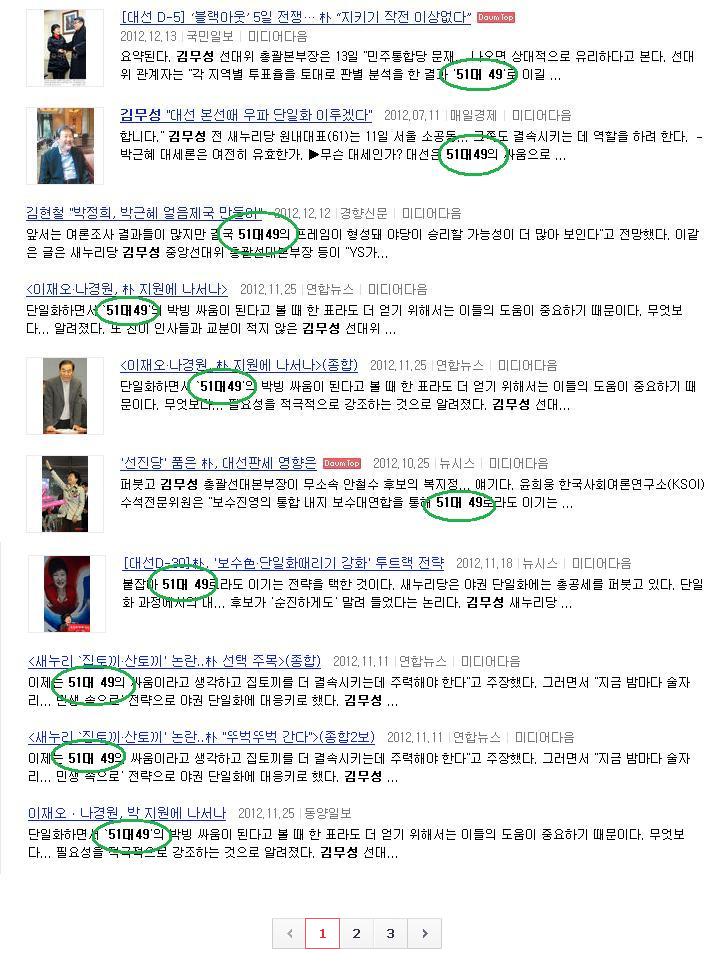
Do you think it was just an accident? Then please keep reading.
The gist of what I'm going to say in this post is as follows: (i) Park Geun-hye was projected to be most likely to win the election, unanimously by South Korea's top three networks (KBS, MBC, and SBS), when merely 20 percent of votes were counted, and projected to win when just 40 percent of votes were counted; (ii) Park had consistently maintained a 3.6 percentage point lead over Moon since 60 percent of votes were counted and consistently earned 100 votes while Moon earned 93 votes every second from 10:77 pm (Dec. 19) through 05:30 am (Dec. 20), for about 7 hours; (iii) President Lee Myung-bak called Park to congratulate her on her win at 9:40 pm (Dec. 19) when just 50 percent of votes were counted (LINK); (v) more than enough South Korean voters (both in South Korea and overseas) are suspecting electronic vote fraud; and (vi) up to 212,064 South Koreans as of 08:40 pm (EST), December 31, have signed petition for the manual count on the 2012 Presidential Election (LINK) and also will file a lawsuit to seek the nullification of the election.
1. Why Are the Results of the Election Not Trustable?
(1) A Large Gap between the Exit Polls and Actual Vote Count Results
Over the past decade, the exit polls have a reputation for accuracy in projecting election results including the winning margin. In the 2002 presidential election, the exit poll indicated a 1.7 percentage point lead for Roh Moo-hyun and he eventually won by a 2.3 percentage point lead. There was just a 0.6 percentage point difference between the exit poll and the actual results. And in the 2010 Seoul City mayoral election, there was just a 0.4 percentage point difference between the exit poll and the actual result. In 2002, the three major S. Korean TV networks (KBS, MBC, and SBS) took the exit poll “separately” and “independently.” During Lee Myung-bak’s administration (2008~present), most of the South Korean media have diminished to be the government’s handmaidens and this year, strangely enough, KBS, MBC, and SBS decided to conduct the “joint” exit poll, all of a sudden.
In the 2012 presidential election, the joint exit poll showed very low accuracy. The “joint” exit poll by KBS, MBC, and SBS indicated a 1.7 percentage point lead for Park Geun-hye but she eventually won by a 3.6 percentage point lead. A 2.4 percentage point difference between the exit poll and the actual result is huge. On the other hand, in the exit poll by OhMyNews, Moon Jae-in was projected to win the election by a 2.4 percentage point lead, beyond the margin of error. All these exit polls had been taken up until 3:00 pm. When we consider the fact that in South Korea, voters in their 50’s and over who tend to lead toward the conservative party tend to do more early voting than the younger generations who tend to lean toward the democratic party, Moon could have won by a huge margin. And in fact, in the poll by YTN, Moon was projected to win the election by a 3.6 percentage point lead.
More than anything, voter turnouts were soaring throughout the Election Day, almost as high as in the 1997 presidential election in which Kim Daejung, the Democratic nominee, won the election and even higher than in the 2002 presidential election in which Roh Moo-hyun, also the Democratic nominee, won the election.

Around 1:00 pm, Park Geun-hye’s Saenuri Party announced they would file a lawsuit to declare invalid election even if Moon won the election, making a false accusation of unlawful acts. According to some reports made around that time, Park’s camp and Saenuri Party were texting one another, stating the emergency while Moon’s camp, the Democratic Party, and the supporters were in a festive mood. According to the resources for reporters, the joint exit poll taken by KBS, MBC, and SBS up until 3:00 pm indicated a 2.2 percentage point lead for Moon (Moon: 50.8%, Park: 48.6%). And all of other independent exit polls were also known to have projected Moon Jae-in to win the election:
Samsung: Moon (50.8%), Park (48.6%)Korea Research: Moon (47%), Park (42%)Reseach View & Stock Firms: Moon (50.4%), Park (48.1%)Research Plus: Moon (50.4%), Park (48.1%)KBS (Independent) and the Blue House indicated about a 3 percentage point lead for Moon.
 Exit poll results conducted by various polling agencies
Exit poll results conducted by various polling agencies were texted to Park Jie-won, the floor leader for Democratic Party
right before the release of the "joint" exit polls by KBS, MBC, and SBS.
All of them projected Moon Jae-in to win the election.
The text message above reads:
Samsung: Moon (50.8%), Park (48.6%)
Korea Research: Moon (47%), Park (42%)
Reseach View & Stock Firms: Moon (50.4%), Park (48.1%)
Research Plus: Moon (50.4%), Park (48.1%)
KBS (Independent), YTN, Blue House indicated a 3 percentage point lead for Moon.
But in less than two hours, at 5:00 pm, KBS, MBC, and SBS unanimously projected Park to win the election (Moon: 48.9%, Park: 50.1%). Unlike past elections, they didn’t even announce and update the hourly exit polls before 5:00 pm. On the other hand, Moon was projected to win by the YTN poll by a 3.6 percentage point lead (Moon: 49.7 ~ 53.5%, Park: 46.1 ~ 49.9%).
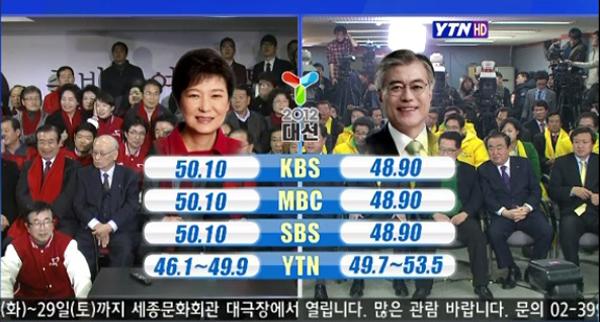
And there’s no more exit polls after 5:00 pm and 2,310,660 people voted after 5 pm. Suppose the joint exit poll was accurate, then in order for Moon to win, he should have earned 57.5% of 2,310,660 votes. But not only did he fail to do so but he lost by a bigger margin than projected. Traditionally, college students and blue/white collar workers tend to start voting around 5:00 pm after their work is over. And they tend to lean toward the progressive party. Here’s one out of many examples: In the 2010 Seoul City mayoral election, Oh Se-hoon of the conservative Grand National Party (former Saenuri Party) was leading by 14 percentage point margin in the morning, by 4 percentage point margin at 4:00 pm, and by 0.6 percentage point margin around closing time as more people voted for Han Myung-sook of the Democratic Party after 4:00 pm.
Did Moon fail to earn 57.5% of 2,310,660 votes cast after 5:00 pm because the voters in their 50’s and over chose to turn out after 5:00 pm this time? And reportedly, voters in their 50’s marked 90% turnout and the media is unanimously making a fuss about it every day. Does it mean the conservative fifty something voters chose to turn out altogether after 5:00 pm, only in this election? Then, let's take a look at the following graphs that indicate the accumulated votes counted by hour in this election. (The original graph is provided by SBS).
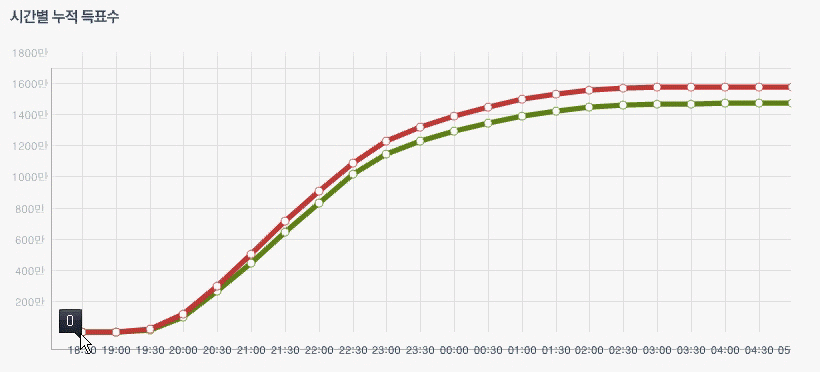
When the voters in their 50’s and over were rushing to turn out after 5:00 pm, when Park was earning enormously larger number of votes than Moon, how could the graphs make such beautiful, consistently smooth curves, indicating a "consistent" 3.6 percentage point lead for Park? This is a very crucial evidence that the election was rigged. We'll discuss this more in detail in section 2 below.
(2) The 2012 South Korean Presidential Election Marked High Voter Turnout: 75.8%
Past elections have shown that the higher the voter turnout, the more likely the progressive party to win. The media and Saenuri Party are now touting the growth in the 50 and over population. It’s true the 50 and over population has increased 10%. Voters in their 50’s reportedly marked 89.9% turnout but they are a limited range of the voters. Thus, we don’t think it’s plausible they were the main reason of the higher-than-usual voter turnout.
(3) Turnout among Voters in Their 50’s was Abnormally High and Turnout among Voters in Their 40’s was Abnormally Low
Voter turnouts of the 1997, 2002, and 2007 presidential elections show a uniform pattern. When we calculate the voter turnout by age based on this pattern, 82% of voters in their 40’s and 80% of voters in their 50’s must have turned out to vote with 75.8% voter turnout. But in fact, in the 2012 presidential election with 75.8% voter turnout, only 78.7% of voters in their 40’s are known to have voted while a tremendously high number of voters in their 50’s (89.9%) have turned out to vote. Let me put it this way. If 51 year-old voters mark 82% turnout, then voters at a certain age group must mark 98% turnout to make 89.9% average turnout possible. So, 89.9% turnout among voters in their 50’s, do you think it’s really possible?
Especially, while the average turnout gap in past elections between voters in their 40’s and those in their 50’s is 7%, the gap in turnout in the 2012 presidential election is 11.2%. When we consider the high turnout in this election, the gap would be approximately 13%. Please beware that the turnout among voters in their 50’s has nothing to do with the growth in the 50’s population. Yet, the leading conservative news media is trying to relate these two variables to justify the nonsensical election results. But the fact of the matter is, the voter turnout by age is not available at this time and they are telling lies with no tangible real numbers.
(UPDATE) There's been a movement among South Korean voters that the names of the registered voters must be double-checked to see if the turnout among the voters in their 50's was not modified. (Related Link: http://www.seoprise.com/board/view.php?table=seoprise_13&uid=185253)
(4) Moon Jae-in Earned 40% of the Vote Cast in Busan
As Busan is a traditional conservative Saenuri Party voting constituency, Moon’s Democratic camp had hoped to get 35% of the vote at the most. But in fact, he got 40% of the vote surpassing their own expectations. This is the best result the Democratic Party has ever had in Busan in the history of South Korean elections. FYI, Roh Moo-hyun won the 2002 presidential election, with only 29.9% of the vote earned in Busan. But Moon lost the 2012 presidential election, even with 39.9% of the vote earned in Busan.
(5) Absentee Voter Turnout was Very High
900,000 absentee voters and 150,000 South Koreans overseas cast their votes ? 1,050,000 votes in all. A majority of absentee voters are younger generations who tend to lean toward the progressive party and absentee voter participation in the 2012 presidential election was tremendously high. Moon also got 56.7% of the vote cast by 150,000 South Koreans overseas while Park got 42.8%.
(6) Only Electronic Counters were Used for Vote Count
Possible election rigging made by the electronic counters in South Korean elections including the 2012 presidential election will be discussed below. In short, this election was Moon Jae-in’s to lose but he really lost by a big margin.
2. Inevitable Connection between Electronic Counting and Man in Power
Even before the 2012 presidential election, there have been some concerns expressed regarding the use of the electronic counters as a means of vote count. Experts like Han Young-soo, a former union head of the National Election Committee say they can pre-program the electronic counters and the National Election Committee s computer to fabricate the election results. The reality is one thing, the virtual reality is another. In other words, the National Election Committee and the TV networks can always release and broadcast the fabricated counting process and results live.
Imagine that you are President Lee Myung-bak with great power and money but with no sense of shame or decency. During your own administration, you have been imbued with corruption. If the Democratic office holds power, then it’s highly likely that you will be subject to criminal prosecution and sent to prison. But you know too well that the electronic counters have serious flaws; that these machines can be easily used to rig the votes so magically. For it was you who asked for the recount in the previous presidential election. Then would you not feel tempted to cheat using these machines? If not, then you would feel uneasy and nervous on Election Day, wouldn’t you? But when South Koreans saw him vote with the First Lady on Election Day, they felt uneasy and nervous instead because the First Couple looked so worry-free and even delighted as if they didn’t care about the election results or already knew the results.

Now click to watch the videos below that show the serious flaws of the electronic counters and errors and fraud made in the South Korean elections.
Electronic Counters: Errors and Fraud in S. Korean Elections
Electronic Counters: Errors and Fraud Simulation
Now, you will see a very surprising analysis provided by SBS, which shows Park got 100 percentage point vote and Moon got 93 percentage point vote consistently every 30 minutes after 22:30 am. Do you think it's ever possible to happen?
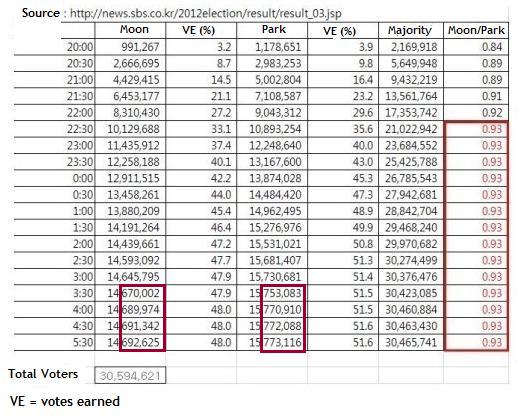
The following chart shows, in fact, Park earned 100 votes and Moon earned 93 votes every second from 22:77 (10:77 pm) through 05:30 am. Do you think this can really happen with no rigging?
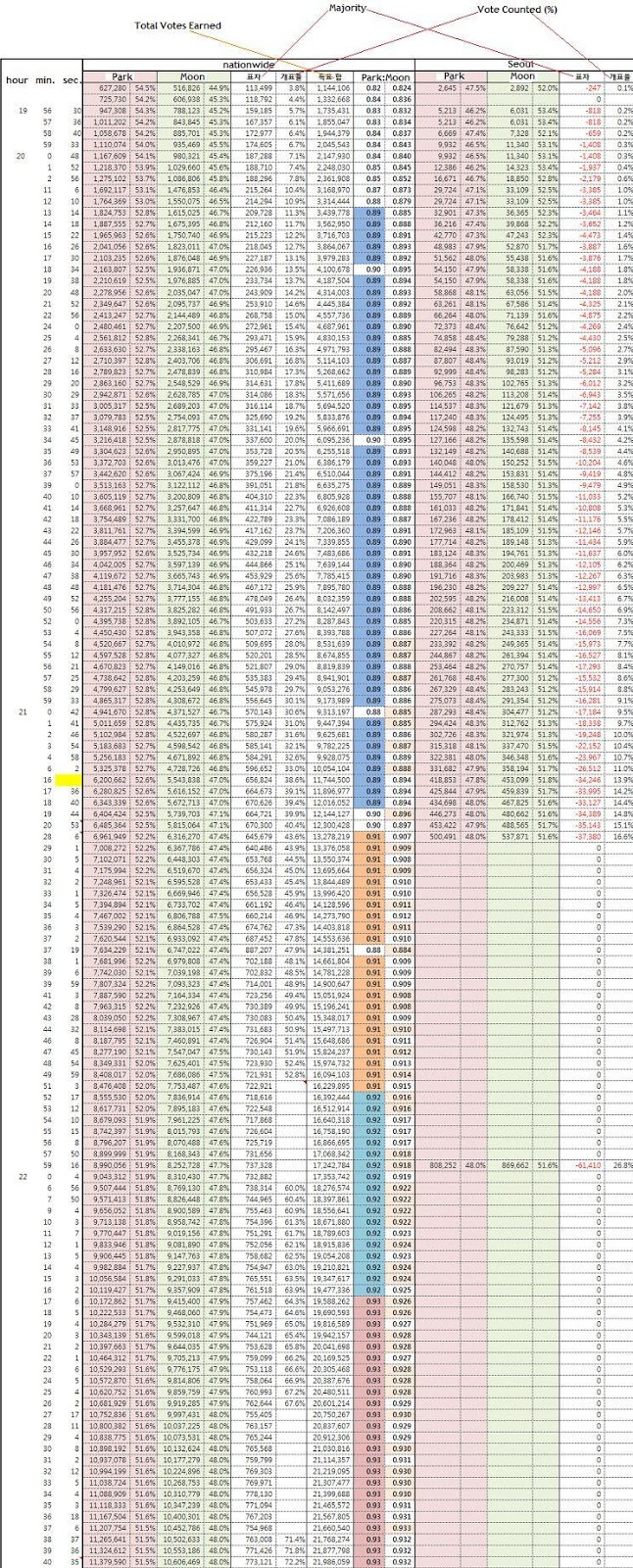
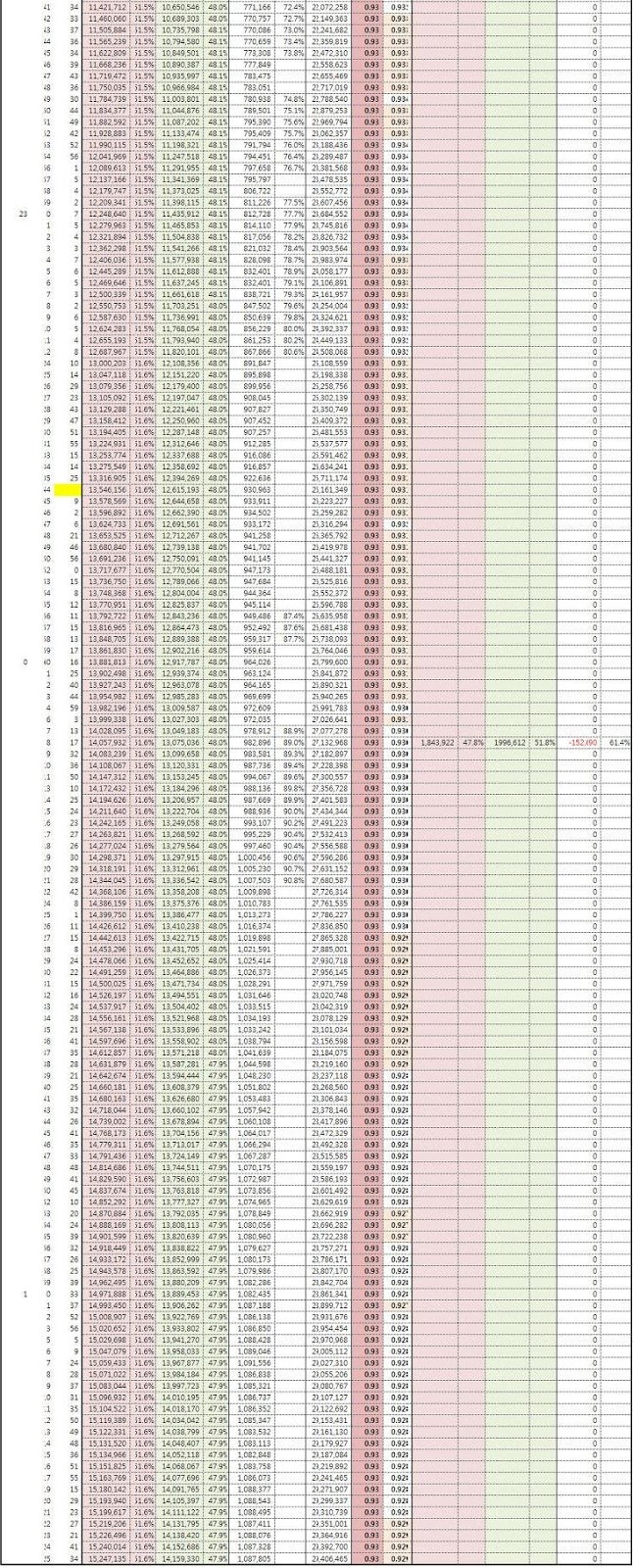
And now let's take a look at the graphs below that indicate the accumulated votes counted by hour in this election.
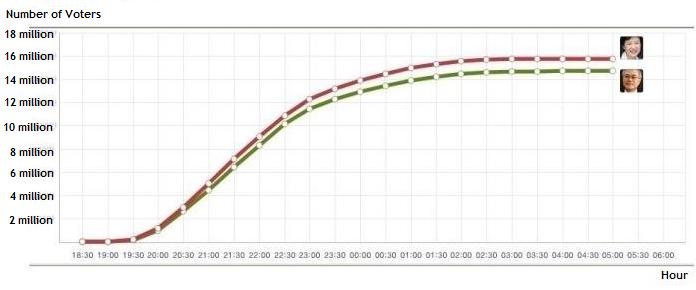
Now, let's compare the above graphs with those which indicate the neck and neck Minnesota senate race between Al Franken and Norm Coleman in 2009. Don't you think the graphs below look more natural even though they don't look as beautiful as those above?

And you know what's more interesting? In the controversial 2008 US senate race between Ted Stevens (Republican) and Mark Begich (Democratic), electronic voting tallies until 8:00 pm were surprisingly non-random just like they were in the 2012 S. Korean presidential election.
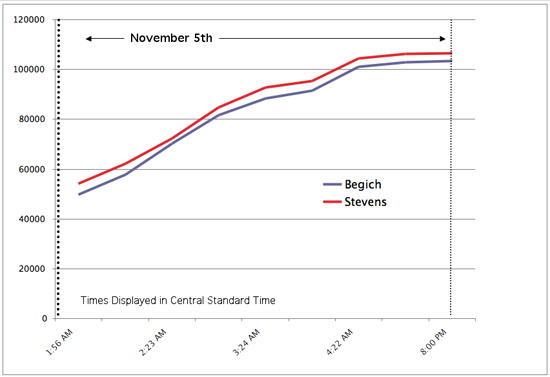
But a vote spread became significantly more random during the hand-counting of the absentee and provisional ballots.
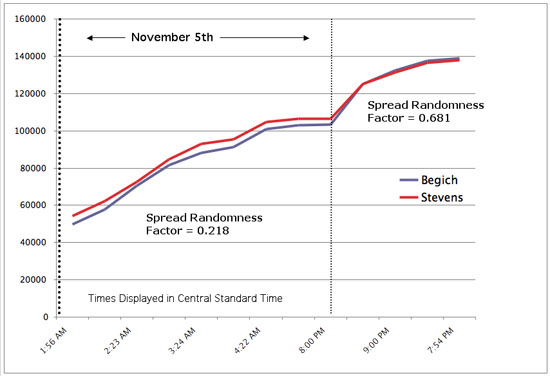
The data depicted in the figure above shows that the measurement of vote spread randomness increased 3 fold for the hand counting process versus the electronic ballot counting process on November 5th.
To sump up, at the end of November 5th Ted Stevens had a 3257-vote lead over Mark Begich and political pundits were declaring the race essentially won by Ted Stevens. That was until it was revealed that over 90,000 absentee and provisional ballots remained to be counted in Alaska, almost 1/3 of all the total ballots that would be cast in this race. And Begich eventually beat Stevens the next day. (Click to learn more about this election.)
Now, let's learn more about the curve that each graph in the 2012 S. Korean presidential election shows. It's called the logistic curve.
(Wikipedia) A logistic function or logistic curve is a common sigmoid function, which may be simply defined by the formula
where the variable P might be considered to denote a population, where e is Euler's number and the variable t might be thought of as time. For values of t in the range of real numbers from ?∞ to +∞, the S-curve shown is obtained. In practice, due to the nature of the exponential function e?t, it is sufficient to compute t over a small range of real numbers such as [?6, +6].
The logistic function finds applications in a range of fields, including artificial neural networks, biology, biomathematics, demography, economics, chemistry, mathematical psychology, probability, sociology, political science, and statistics.
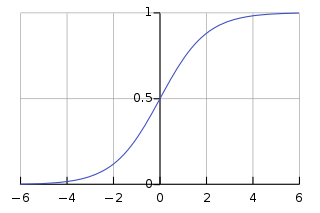 Standard logistic sigmoid function
Standard logistic sigmoid functionThe fact that a graph that indicates the accumulated vote-count by hour shows such a smooth generalized logistic curve is never a common or natural thing to happen. To top it off, it's not even one graph, but both of the graphs that indicates the accumulated votes earned by both candidates. Don't you think it's really artificial?
Unlike in the US presidential election, these graphs that indicate the accumulated vote count for both candidates (by hour) reflect the votes earned "nationwide." Therefore, the percent of votes earned should continuously fluctuate or keep turning around according to which party the voters in some precinct whose votes are currently counted are leaning toward or according to the speed the votes are opened and counted. That's been the way our past elections looked like, especially the presidential elections that reflect the votes from nationwide which tend to lean strongly toward a certain candidate according to the precinct the votes are from.
But the 2012 presidential election didn't show even a little fluctuation, maintaining a consistent 3.6 percentage point lead for Park for about 7 hours, just as seen in the beautifully smooth generalized logistic curve above. The logistic curve is given by the "formula" while the election results are not. In other words, how could the actual election results show the logistic distribution? Weird, right?
Just imagine someone had used a logistic function to model the number of votes to be earned by hour and pre-calculated the number of votes earned by hour accordingly; he had hacked into the tallying and reporting of the votes counted; and he substituted the pre-calculated number of votes for that of votes counted at the voting station. Then the number of votes counted broadcast by hour could have been completely different from those counted at the voting station; and the voters watching the hourly results on TV must have believed what they saw to be real without knowing it was just virtual. Compare now the following two charts. Can you see any difference? Both charts indicate the votes earned every hour by Park Geun-hye but the left was calculated by the logistic probability pre-programmed by the logistic function while the right was the actual votes earned by Park, which was broadcast by SBS.
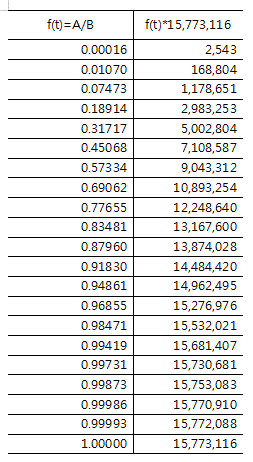
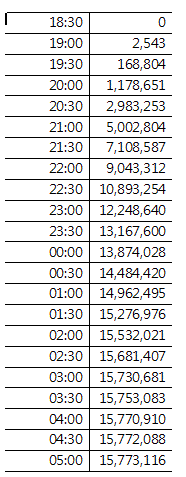
Of course, we can’t vouch for the case but it’s just our assumption as the votes are yet to be counted “manually” and it's not like anyone has ever blown the whistle. That’s why we need to check everything thoroughly: We need to “manually” check the actual votes counted; we need to check the process in which the voting results counted were transmitted via computer, tallied, and reported; we need to have the names of actual voters, the number of votes actually counted at the voting station, the number of votes transmitted via computer to be tallied, and the number of votes broadcast by networks in hand; and we need to compare them with one another and check them against one another to get the accurate number of votes earned by each candidate.
By the way, I will give you very interesting yet fishy news. On June 30, 2012, DongA Dailyreported President Lee Myung-bak secretly flew to San Francisco on June 25 to meet up with Kim Moo-sung, a former floor leader of Saenuri Party, who was "backpacking" in the US at that time; and on June 29, 2012, NoCut News reported Yim Tae-hee, a former Blue House Chief of Staff, also flew to the US on June 21 to meet up with Kim Moo-sung. Later, Kim, who had been famous for being anti-Park Geun-hye, joined her camp to serve as chief campaign manager for Park. Accident? I don't think so. Can you believe 61-year-old Kim Moo-sung, a four-time lawmaker and former floor leader of Saenuri Party, was really backpacking in the US?; and President Lee Myung-bak and Yim Tae-hee, a former Blue House Chief of Staff, flew to have a chat with him? What was Kim Moo-sung doing in the US? FYI, the Park Geun-hye camp later hired a team of election maneuver experts from US and a lot of South Koreans are now suspecting they helped her camp rig the election. For example, Kim Moo-sung hired Ahn Byung-do, a former National Election Committee Chief of Public Affairs, and had him serve as Park's Special Adviser in this election. Please watch him explain about the electronic vote counting system while working for the National Election Committee.
On December 26, 2012, Won Joon-hee, Secretary of the National Election Committee, had aninterview with CBS Radio and said they counted all the votes manually and used the electronic counters only to sort the votes. But as I mentioned above, Park Geun-hye was projected to be most likely to win the election, unanimously by South Korea's top three networks (KBS, MBC, and SBS), when merely 20 percent of votes were counted, and projected to win when just 40 percent of votes were counted. In other words, she was projected to win the election in 3 hours after the vote was closed as Ahn Byung-do, Park's Special Adviser and former.National Election Committee Chief of Public Affairs, boasted in the video above. He said the computer could read 15,000 votes per hour. Do you think humans can do the same thing? Really?
And strangely enough, just a day before the 2012 presidential election, Ahn Dae-hee, the chairman of the Committee of Political Reform of Saenuri Party, who had worked for Park's campaign, suddenly vanished (LINK); and just two days after Park Geun-hye was announced S. Korea's president-elect, Kim Moo-sung also disappeared leaving a note posted to his office door saying, "I've done my job and I need to take a break." (LINK) Don't you think they have been moving exactly according to the previously made scenarios?
3. Other Unlawful Acts Associated with Vote Count
(1) Evidences for Unlawful Acts Associated with Vote Count
Since the Election Day, South Koreans have been raising suspicions that there were unlawful acts associated with S. Korea's presidential vote count, including “8 million” ballots votes declared invalid and left unaccounted for or bunches of votes for Park Geun-hye found folded together, to name a few. FYI, in South Korean elections, people stamp the ballot paper and both of the votes shown below must be invalidated. But in the 2012 presidential election, invalid votes cast for Park Geun-hey were declared valid while those cast for Moon Jae-in were declared invalid:
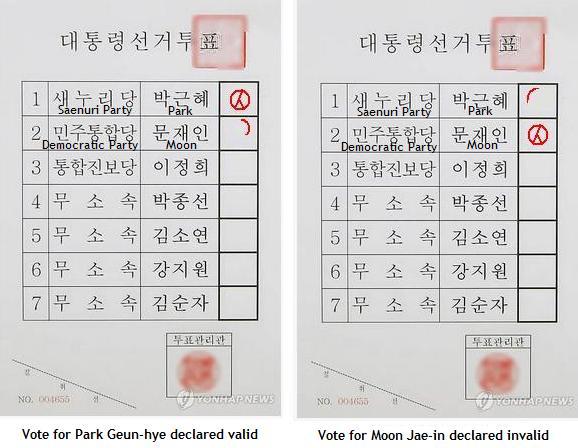
 Invalid votes declared to be for Park Geun-hye
Invalid votes declared to be for Park Geun-hye
 Votes for Moon Jae-in found in a tray for votes for Park Geun-hye
Votes for Moon Jae-in found in a tray for votes for Park Geun-hye A bunch of votes for Park Geun-hye folded together
A bunch of votes for Park Geun-hye folded togetherfound in Andong voting center
 A bunch of votes for Park Geun-hye folded together
A bunch of votes for Park Geun-hye folded togetherBut most importantly, According to Han Young-soo, a former union head of the National Election Committee, the very first broadcast of the 2012 presidential election results proved that there were unlawful, corrupt acts associated with vote count. (Please scroll down to watch his interview (with English subtitles).) YTN was the first network to release the election results from the voting centers around the nation. Under the South Korean Public Official Election Act, 100 votes should be hand-counted, screened, bundled together of 100, then signed and sealed by the election board. And the official result of each bundle is officially announced by the chairman of the regional election committee, transmitted to the National Election Committee and then broadcast by the networks. When YTN broadcast the early results from Danyang or Hoengseong, however, votes less than 100 were released as shown in the following pictures.
 YTN reports the results from Danyang, Chungbuk Province
YTN reports the results from Danyang, Chungbuk Province YTN reports the results from Hoengseong, Gangwon Province
YTN reports the results from Hoengseong, Gangwon ProvinceThis means the votes were “not” manually counted, or screened, or put in bundles of 100, or signed and sealed by the election board. And the official result of each bundle was “not” officially announced by the chairman of the regional election committee or transmitted to the National Election Committee And this election should be invalidated as the National Election Committee committed unlawful acts which were strongly related to the unlawful use of the electronic counter for the actual counting, not just for sorting. This means the National Election Committee has also diminished to be the government’s handmaiden and systematically committed unlawful acts in South Korea’s presidential election in connivance with the TV networks.
Now please watch the video below that features in interview with Han Young-soo, a former union head of the National Election Committee who talks about unlawful acts committed by South Korean National Election Committee in the 2012 presidential election.
Han Young-soo Interview about the 2012 S. Korean Presidential Election Rigging
Evidence 1 of Unlawful Acts Caught in the Andong Voting Station
Evidence 2 of Unlawful Acts Caught in the Andong Voting Station
(2) Possible Unlawful Acts in Absentee Vote and Overseas Vote
Votes are counted immediately after voting ends. But the absentee votes and overseas votes are counted respectively 5 days and 9 days after voting ends. Therefore, there’s a security risk for ballot boxes since early vote count is not allowed. Unless the official supervisors from each party keep a close watch on the boxes 24/7, anyone can always open them and rig the vote. For instance, in the 2011 Seoul City mayoral by-election that Park Won-soon of the Democratic Party won 53.2% to 46.4%, Na Kyung-won of conservative Saenuri Party earned 54.7% of the absentee vote.
More importantly, the ballot boxes in the 2012 presidential election were made from plastic and accordingly, the security seals and safety latches can always be removed from and applied back to the plastic ballot boxes without damaging.

 The safety latches were also made from plastic.
The safety latches were also made from plastic. A ballot box with no security seal
A ballot box with no security seal Extra ballot boxes with no seals hidden behind found by a voter
Extra ballot boxes with no seals hidden behind found by a voter The twitter message above reads: 18 suspicious ballot boxes found so far.
The twitter message above reads: 18 suspicious ballot boxes found so far.This box came in unlocked.
The election board official was caught while hurriedly trying to lock it.
 One of the ballot boxes made of metal
One of the ballot boxes made of metalused during Roh Moo-hyun's administration
Besides, the ballot envelopes were transparent so anyone can see who the votes were for, which means anyone can selectively pick out and switch or discard the votes. This is a clear violation of the constitution that guarantees secret ballots.
 Picture taken at 2012 S. Korean presidential election voting center
Picture taken at 2012 S. Korean presidential election voting centerAnd the absentee ballot envelopes were transparent, too.

3. Manual Count Must be Done Immediately
A. Tentative count (electronic counting) was done.B. Formal count (manual counting) has not started yet.C. The election results are not officially confirmed.
Under the South Korean Public Official Election Act, the electronic counters cannot be used in elections, but only in by-elections by mutual consent (with other parties). So if the National Election Committee refuses to do the manual counting, then the election itself should be nullified as they are violating the South Korean Public Official Election Act.
Do you remember the Florida election recount of 2000 US presidential election? And the South Korean presidential election recount of 2002? After the recount, President Roh Moo-hyun’s election was legally/officially assured. Recount is our right guaranteed by the constitution. And we’re not even asking for recount; we’re asking for the formal manual counting that is regulated by the constitution. Why are the Lee Myung-bak administration, the National Election Committee and the political parties violating the law? This is a serious constitutional crime that impinges voting rights and election law.
More accurately speaking, the electronic counters are merely sorting machines that are used to sort votes to accelerate the counting processes. That’s why the manual counting must follow to verify the serial numbers, invalid votes, misplaced votes, and so on. And this is regulated by the South Korean Public Official Election Act. In short, the actual counting must go on. Why did they leave the counting held in suspension?
All the votes were “sorted” now. And based on the tentative results, South Korean media projected Park Geun-hye to win the election. Now, it’s time for the real counting.
And now, South Koreans are signing petition for the manual count on the 2012 Presidential Election (LINK) and also will file a lawsuit to seek the nullification of the election.
 http://i1.daumcdn.net/img-section/agora2/m2/ico_agora_m2.gif");overflow:hidden;">스크랩
http://i1.daumcdn.net/img-section/agora2/m2/ico_agora_m2.gif");overflow:hidden;">스크랩 신고
신고 행복한차도남의 최근 게시물
행복한차도남의 최근 게시물


